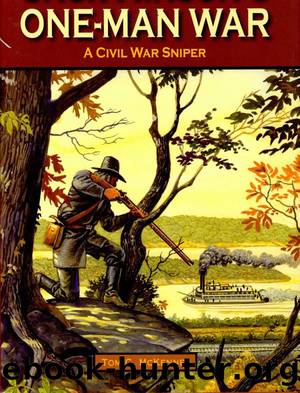Jack Hinson's One-Man War by Tom McKenney

Author:Tom McKenney
Language: eng
Format: epub
Publisher: Pelican Publishing
Published: 2022-01-15T00:00:00+00:00
Chapter 6
Twilight at Bubbling Springs: The Last Summer and Autumn
âThe dreamy, sun-washed days of that blessed summer and autumn would soon be followed by the darkest winter of their lives.â
As the summer of 1863 settled into an endless succession of hot nights followed by still-hotter days, the occupation force looked upon the Hinsons with increasingly cold eyes. Aware of, but not intimidated by, the hostile attention from the occupation forces, the Hinson family, both black and white, went on with their work, following the timeless, seasonal rhythms of past years and past generations.
Colonel Lowe and the Fifth Iowa Cavalry Depart
On June 8, Colonel Lowe and his Fifth Iowa Cavalry left the Twin Rivers and decamped for Murfreesboro to become part of the First Brigade, Second Division, Fourteenth Corps and follow the war eastward. They would never return. Col. William P. Lyon assumed command at Fort Donelson, but the situation didnât improve. In fact, the situation was even more difficult for Colonel Lyon because the Thirteenth Wisconsin and the Seventy-first Ohio were infantry regiments, which made it almost impossible for him to react adequately to the fast-moving Confederate cavalry units and mounted bands of guerrillas such as Robert Hinsonâs Raiders. The Confederates in the area continued to strike and with more freedom than before.1
In June, the early apples ripened and were a welcome treat in any form: raw, soft and juicy, cooked into applesauce and pies, or fried with sugar and sausage. June apples were good in any form, but their applesauce was best.
June also brought haying timeâthe cutting and housing of the early hay. The hay was mowed with scythes, and the mowing entrusted only to the older, experienced men. They moved across the field, side by side but staggered, rear to front so as not to cut one another, with each cutting his own swath, the sharpened blades swinging smoothly, rhythmically, with long-practiced efficiency and economy of motion. Behind the mowers, and after the hay was sufficiently cured in the swath, came the sweeps. The hay was raked into windrows with a âsweepâ made of a long log, from which slender, long poles, pointed on the tips, projected forward perpendicularly like the teeth of a giant comb. With a mule hitched to each end of the log, the sweep would slide under the mown hay and accumulate it in long windrows, backing out from under each portion as that row grew to go get some more. When the hay was further cured, the wagons followed. The hands walked beside the wagons, forking the hay from the windrows onto the wagons, where it was carefully arranged so that the load could be built high without falling off the wagon. At the barn, it was forked into the loft to become the basic supply of feed, laid up to sustain the stock through the coming winter.
Through the summer, they cultivated corn, âbustinâ the middlesâ to control the grass and weeds; what the cultivator couldnât get, the scraping hoes did. Their patch of cotton received the same care.
Download
This site does not store any files on its server. We only index and link to content provided by other sites. Please contact the content providers to delete copyright contents if any and email us, we'll remove relevant links or contents immediately.
| United States | Abolition |
| Campaigns & Battlefields | Confederacy |
| Naval Operations | Regimental Histories |
| Women |
In Cold Blood by Truman Capote(3346)
The Innovators: How a Group of Hackers, Geniuses, and Geeks Created the Digital Revolution by Walter Isaacson(2994)
Steve Jobs by Walter Isaacson(2857)
All the President's Men by Carl Bernstein & Bob Woodward(2346)
Lonely Planet New York City by Lonely Planet(2194)
And the Band Played On by Randy Shilts(2165)
The Room Where It Happened by John Bolton;(2133)
The Poisoner's Handbook by Deborah Blum(2108)
The Murder of Marilyn Monroe by Jay Margolis(2078)
The Innovators by Walter Isaacson(2075)
Lincoln by David Herbert Donald(1964)
A Colony in a Nation by Chris Hayes(1901)
Being George Washington by Beck Glenn(1776)
Under the Banner of Heaven: A Story of Violent Faith by Jon Krakauer(1765)
Amelia Earhart by Doris L. Rich(1669)
The Unsettlers by Mark Sundeen(1658)
Dirt by Bill Buford(1649)
Birdmen by Lawrence Goldstone(1639)
Zeitoun by Dave Eggers(1617)
